Satellite-Observed Variations and Trends in Carbon Monoxide over Asia and Their Sensitivities to Biomass Burning
Abstract
1. Introduction
2. Data and Methods
2.1. Study Area, Study Period, and Statistics Analysis
2.2. Satellite Carbon Monoxide Data and Analysis
2.3. Fire Count and Emission Data and Land Cover Data
3. Results
3.1. Temporal–Spatial Variations and Trends in Atmospheric Carbon Monoxide over Asia
3.1.1. Spatial Variations in Atmospheric Carbon Monoxide over Asia in the Annual Mean and by Season
3.1.2. Interannual Variation in Atmospheric Carbon Monoxide over Asia
3.1.3. Trends in Atmospheric Carbon Monoxide over Asia from 2003–2017
3.2. Correlations between Biomass Burning and the Interannual Variations and Trends in Atmospheric Carbon Monoxide over Asia
3.2.1. Sensitivity of the Interannual Variation in Carbon Monoxide over Asia to Biomass Burning
3.2.2. Comparison of the Trend in Atmospheric Carbon Monoxide with the Trend in Biomass Burning in Asia
4. Discussion
4.1. Temporal–Spatial Variations and Trends in Atmospheric Carbon Monoxide over Asia
4.2. Impacts of Biomass Burning on the Interannual Variation and Trend in Atmospheric Carbon Monoxide over Asia
4.3. Comparison of Atmospheric Carbon Monoxide over Asia Observed by MOPITT and AIRS
5. Conclusions
Data availability
Supplementary Materials
Author Contributions
Funding
Acknowledgments
Conflicts of Interest
References
- Holloway, T.; Levy Ii, H.; Kasibhatla, P. Global distribution of carbon monoxide. J. Geophys. Res. Atmos. 2000, 105, 12123–12147. [Google Scholar] [CrossRef]
- Jacob, D.J. Introduction to Atmospheric Chemistry; Princeton University Press: Princeton, NJ, USA, 2000. [Google Scholar]
- Yurganov, L.N.; McMillan, W.W.; Dzhola, A.V.; Grechko, E.I.; Jones, N.B.; Van der Werf, G.R. Global AIRS and MOPITT CO measurements: Validation, comparison, and links to biomass burning variations and carbon cycle. J. Geophys. Res. Atmos. 2008, 113, D09301. [Google Scholar] [CrossRef]
- Logan, J.A.; Prather, M.J.; Wofsy, S.C.; McElroy, M.B. Tropospheric chemistry: A global perspective. J. Geophys. Res. Oceans 1981, 86, 7210–7254. [Google Scholar] [CrossRef]
- Ding, K.; Liu, J.; Ding, A.; Liu, Q.; Zhao, T.L.; Shi, J.; Han, Y.; Wang, H.; Jiang, F. Uplifting of carbon monoxide from biomass burning and anthropogenic sources to the free troposphere in East Asia. Atmos. Chem. Phys. 2015, 15, 2843–2866. [Google Scholar] [CrossRef]
- Drummond, J.R.; Mand, G.S. The Measurements of Pollution in the Troposphere (MOPITT) Instrument: Overall Performance and Calibration Requirements. J. Atmos. Ocean. Technol. 1996, 13, 314–320. [Google Scholar] [CrossRef][Green Version]
- Deeter, M.N.; Edwards, D.P.; Gille, J.C.; Drummond, J.R. Sensitivity of MOPITT observations to carbon monoxide in the lower troposphere. J. Geophys. Res. Atmos. 2007, 112, D24. [Google Scholar] [CrossRef]
- Warner, J.; Comer, M.M.; Barnet, C.D.; McMillan, W.W.; Wolf, W.; Maddy, E.; Sachse, G. A comparison of satellite tropospheric carbon monoxide measurements from AIRS and MOPITT during INTEX-A. J. Geophys. Res. Atmos. 2007, 112, D12. [Google Scholar] [CrossRef]
- Bremer, H.; Kar, J.; Drummond, J.R.; Nichitu, F.; Zou, J.; Liu, J.; Gille, J.C.; Deeter, M.N.; Francis, G.; Ziskin, D.; et al. Spatial and temporal variation of MOPITT CO in Africa and South America: A comparison with SHADOZ ozone and MODIS aerosol. J. Geophys. Res. Atmos. 2004, 109, 12301–12310. [Google Scholar] [CrossRef]
- Clerbaux, C.; Boynard, A.; Clarisse, L.; George, M.; Hadji-Lazaro, J.; Herbin, H.; Hurtmans, D.; Pommier, M.; Razavi, A.; Turquety, S.; et al. Monitoring of atmospheric composition using the thermal infrared IASI/MetOp sounder. Atmos. Chem. Phys. 2009, 9, 6041–6054. [Google Scholar] [CrossRef]
- Palve, S.N.; Nemade, P.D.; Ghude, S.D. MOPITT carbon monoxide its source distributions, interannual variability and transport pathways over India during 2005-2015. Int. J. Remote Sens. 2018, 39, 5952–5964. [Google Scholar] [CrossRef]
- Zhang, L.; Jiang, H.; Lu, X.; Jin, J. Comparison analysis of global carbon monoxide concentration derived from SCIAMACHY, AIRS, and MOPITT. Int. J. Remote Sens. 2016, 37, 5155–5175. [Google Scholar] [CrossRef]
- Kar, J.; Jones, D.B.A.; Drummond, J.R.; Attié, J.L.; Liu, J.; Zou, J.; Nichitiu, F.; Seymour, M.D.; Edwards, D.P.; Deeter, M.N.; et al. Measurement of low-altitude CO over the Indian subcontinent by MOPITT. J. Geophys. Res. Atmos. 2008, 113, D16. [Google Scholar] [CrossRef]
- Gloudemans, A.M.S.; De Laat, A.T.J.; Schrijver, H.; Aben, I.; Meirink, J.F.; Van Der Werf, G.R. SCIAMACHY CO over land and oceans: 2003-2007 interannual variability. Atmos. Chem. Phys. 2009, 9, 3799–3813. [Google Scholar] [CrossRef]
- Girach, I.A.; Nair, P.R. Carbon monoxide over Indian region as observed by MOPITT. Atmos. Environ. 2014, 99, 599–609. [Google Scholar] [CrossRef]
- Ul-Haq, Z.; Rana, A.D.; Ali, M.; Mahmood, K.; Tariq, S.; Qayyum, Z. Carbon monoxide (CO) emissions and its tropospheric variability over Pakistan using satellite-sensed data. Adv. Space Res. 2015, 56, 583–595. [Google Scholar] [CrossRef]
- Osman, M.K.; Tarasick, D.W.; Liu, J.; Moeini, O.; Thouret, V.; Fioletov, V.E.; Parrington, M.; Nédélec, P. Carbon monoxide climatology derived from the trajectory mapping of global MOZAIC-IAGOS data. Atmos. Chem. Phys. 2016, 16, 10263–10282. [Google Scholar] [CrossRef]
- Bai, W.; Zhang, P.; Zhang, X.; Wang, W.; Qi, J.; Liu, H.; Zhang, W.; Bianba, C. Temporal and spatial distribution characteristics of carbon monoxide column amount over China based on satellite data. J. Appl. Meteorol. Sci. 2010, 21, 473–483. [Google Scholar]
- Worden, H.M.; Deeter, M.N.; Frankenberg, C.; George, M.; Nichitiu, F.; Worden, J.; Aben, I.; Bowman, K.W.; Clerbaux, C.; Coheur, P.F.; et al. Decadal record of satellite carbon monoxide observations. Atmos. Chem. Phys. 2013, 13, 837–850. [Google Scholar] [CrossRef]
- Jiang, Z.; Jones, D.B.A.; Worden, H.M.; Henze, D.K. Sensitivity of top-down CO source estimates to the modeled vertical structure in atmospheric CO. Atmos. Chem. Phys. 2015, 15, 1521–1537. [Google Scholar] [CrossRef]
- Duncan, B.N.; Logan, J.A.; Bey, I.; Megretskaia, I.A.; Yantosca, R.M.; Novelli, P.C.; Jones, N.B.; Rinsland, C.P. Global budget of CO, 1988–1997: Source estimates and validation with a global model. J. Geophys. Res. Atmos. 2007, 112, D22. [Google Scholar] [CrossRef]
- Wang, P.; Elansky, N.F.; Timofeev, Y.M.; Wang, G.; Golitsyn, G.S.; Makarova, M.V.; Rakitin, V.S.; Shtabkin, Y.; Skorokhod, A.I.; Grechko, E.I.; et al. Long-term trends of carbon monoxide total columnar amount in urban areas and background regions: Ground- and satellite-based spectroscopic measurements. Adv. Atmos. Sci. 2018, 35, 785–795. [Google Scholar] [CrossRef]
- Ul-Haq, Z.; Tariq, S.; Ali, M. Anthropogenic emissions and space-borne observations of carbon monoxide over South Asia. Adv. Space Res. 2016, 58, 1610–1626. [Google Scholar] [CrossRef]
- Zheng, B.; Chevallier, F.; Yin, Y.; Ciais, P.; Fortems-Cheiney, A.; Deeter, M.N.; Parker, R.J.; Wang, Y.; Worden, H.M.; Zhao, Y. Global atmospheric carbon monoxide budget 2000-2017 inferred from multi-species atmospheric inversions. Earth Sys. Sci. Data 2019, 11, 1411–1436. [Google Scholar] [CrossRef]
- Yin, S.; Wang, X.; Zhang, X.; Guo, M.; Miura, M.; Xiao, Y. Influence of biomass burning on local air pollution in mainland Southeast Asia from 2001 to 2016. Environ. Pollut. 2019, 254, 112949. [Google Scholar] [CrossRef] [PubMed]
- Granier, C.; Bessagnet, B.; Bond, T.; D’Angiola, A.; van der Gon, H.D.; Frost, G.J.; Heil, A.; Kaiser, J.W.; Kinne, S.; Klimont, Z.; et al. Evolution of anthropogenic and biomass burning emissions of air pollutants at global and regional scales during the 1980–2010 period. Clim. Chang. 2011, 109, 163–190. [Google Scholar] [CrossRef]
- Van Der Werf, G.R.; Randerson, J.T.; Giglio, L.; Van Leeuwen, T.T.; Chen, Y.; Rogers, B.M.; Mu, M.; Van Marle, M.J.E.; Morton, D.C.; Collatz, G.J.; et al. Global fire emissions estimates during 1997–2016. Earth Syst. Sci. Data 2017, 9, 697–720. [Google Scholar] [CrossRef]
- Sinha, P.; Hobbs, P.V.; Yokelson, R.J.; Blake, D.R.; Gao, S.; Kirchstetter, T.W. Distributions of trace gases and aerosols during the dry biomass burning season in southern Africa. J. Geophys. Res. Atmos. 2003, 108, ACH 4-1–ACH 4-23. [Google Scholar] [CrossRef]
- Kganyago, M.; Shikwambana, L. Assessing spatio-temporal variability of wildfires and their impact on sub-Saharan ecosystems and air quality using multisource remotely sensed data and trend analysis. Sustainability 2019, 11, 6811. [Google Scholar] [CrossRef]
- Zheng, B.; de Beurs, K.M.; Owsley, B.C.; Henebry, G.M. Scaling relationship between CO pollution and population size over major US metropolitan statistical areas. Landsc. Urban Plan. 2019, 187, 191–198. [Google Scholar] [CrossRef]
- Liu, J.; Drummond, J.R.; Li, Q.; Gille, J.C.; Ziskin, D.C. Satellite mapping of CO emission from forest fires in Northwest America using MOPITT measurements. Remote Sens. Environ. 2005, 95, 502–516. [Google Scholar] [CrossRef]
- Zheng, B.; Chevallier, F.; Ciais, P.; Yin, Y.; Deeter, M.N.; Worden, H.M.; Wang, Y.; Zhang, Q.; He, K. Rapid decline in carbon monoxide emissions and export from East Asia between years 2005 and 2016. Environ. Res. Lett. 2018, 13, 44007. [Google Scholar] [CrossRef]
- Kang, H.Q.; Zhu, B.; van der A, R.J.; Zhu, C.M.; de Leeuw, G.; Hou, X.W.; Gao, J.H. Natural and anthropogenic contributions to long-term variations of SO2, NO2, CO, and AOD over East China. Atmos. Res. 2019, 215, 284–293. [Google Scholar] [CrossRef]
- Li, Y.; Liu, J.; Han, H.; Zhao, T.; Zhang, X.; Zhuang, B.; Wang, T.; Chen, H.; Wu, Y.; Li, M. Collective impacts of biomass burning and synoptic weather on surface PM2.5 and CO in Northeast China. Atmos. Environ. 2019, 213, 64–80. [Google Scholar] [CrossRef]
- Paton-Walsh, C.; Deutscher, N.M.; Griffith, D.W.T.; Forgan, B.W.; Wilson, S.R.; Jones, N.B.; Edwards, D.P. Trace gas emissions from savanna fires in northern Australia. J. Geophys. Res. Atmos. 2010, 115, D16314. [Google Scholar] [CrossRef]
- Yurganov, L.N.; Blumenstock, T.; Grechko, E.I.; Hase, F.; Hyer, E.J.; Kasischke, E.S.; Koike, M.; Kondo, Y.; Kramer, I.; Leung, F.Y.; et al. A quantitative assessment of the 1998 carbon monoxide emission anomaly in the Northen Hemisphere based on total column and surface concentration measurements. J. Geophys. Res. Atmos. 2004, 109, 15301–15313. [Google Scholar] [CrossRef]
- Yurganov, L.N.; Duchatelet, P.; Dzhola, A.V.; Edwards, D.P.; Hase, F.; Kramer, I.; Mahieu, E.; Mellqvist, J.; Notholt, J.; Novelli, P.C.; et al. Increased Northern Hemispheric carbon monoxide burden in the troposphere in 2002 and 2003 detected from the ground and from space. Atmos. Chem. Phys. 2005, 5, 563–573. [Google Scholar] [CrossRef]
- Lalitaporn, P.; Kurata, G.; Matsuoka, Y.; Thongboonchoo, N.; Surapipith, V. Long-term analysis of NO2, CO, and AOD seasonal variability using satellite observations over Asia and intercomparison with emission inventories and model. Air Qual. Atmos. Health 2013, 6, 655–672. [Google Scholar] [CrossRef]
- Streets, D.G.; Yarber, K.F.; Woo, J.H.; Carmichael, G.R. Biomass burning in Asia: Annual and seasonal estimates and atmospheric emissions. Glob. Biogeochem. Cycles 2003, 17, 10–11. [Google Scholar] [CrossRef]
- Worden, J.; Jiang, Z.; Jones, D.B.A.; Alvarado, M.; Bowman, K.; Frankenberg, C.; Kort, E.A.; Kulawik, S.S.; Lee, M.; Liu, J.; et al. El Niño, the 2006 Indonesian peat fires, and the distribution of atmospheric methane. Geophys. Res. Lett. 2013, 40, 4938–4943. [Google Scholar] [CrossRef]
- Nechita-Banda, N.; Krol, M.; Van Der Werf, G.R.; Kaiser, J.W.; Pandey, S.; Huijnen, V.; Clerbaux, C.; Coheur, P.; Deeter, M.N.; Röckmann, T. Monitoring emissions from the 2015 Indonesian fires using CO satellite data. Philos. Trans. R. Soc. B Biol. Sci. 2018, 373. [Google Scholar] [CrossRef]
- Ziskin, D. MOPITT Level 3 CO Gridded Monthly Means (Near and Thermal Infrared Radiances) HDF File-Version 7; NASA Langley Research Center Atmospheric Science Data Center DAAC: Hampton, VA, USA, 2016. [Google Scholar] [CrossRef]
- Warner, J.; Carminati, F.; Wei, Z.; Lahoz, W.; Attié, J.L. Tropospheric carbon monoxide variability from AIRS under clear and cloudy conditions. Atmos. Chem. Phys. 2013, 13, 12469–12479. [Google Scholar] [CrossRef]
- McMillan, W.W.; Evans, K.D.; Barnet, C.D.; Maddy, E.S.; Sachse, G.W.; Diskin, G.S. Validating the AIRS version 5 CO retrieval with DACOM in situ measurements during INTEX-A and -B. IEEE Trans. Geosci. Remote Sens. 2011, 49, 2802–2813. [Google Scholar] [CrossRef]
- Miyazaki, K.; Eskes, H.J.; Sudo, K. A tropospheric chemistry reanalysis for the years 2005-2012 based on an assimilation of OMI, MLS, TES, and MOPITT satellite data. Atmos. Chem. Phys. 2015, 15, 8315–8348. [Google Scholar] [CrossRef]
- Giglio, L.; Csiszar, I.; Justice, C.O. Global distribution and seasonality of active fires as observed with the Terra and Aqua Moderate Resolution Imaging Spectroradiometer (MODIS) sensors. J. Geophys. Res. Biogeosci. 2006, 111, G2. [Google Scholar] [CrossRef]
- Giglio, L.; Randerson, J.T.; Van Der Werf, G.R. Analysis of daily, monthly, and annual burned area using the fourth-generation global fire emissions database (GFED4). J. Geophys. Res. Biogeosci. 2013, 118, 317–328. [Google Scholar] [CrossRef]
- Wotawa, G.; Novelli, P.C.; Trainer, M.; Granier, C. Inter-annual variability of summertime CO concentrations in the Northern Hemisphere explained by boreal forest fires in North America and Russia. Geophys. Res. Lett. 2001, 28, 4575–4578. [Google Scholar] [CrossRef]
- Duncan, B.N.; Martin, R.V.; Staudt, A.C.; Yevich, R.; Logan, J.A. Interannual and seasonal variability of biomass burning emissions constrained by satellite observations. J. Geophys. Res. Atmos. 2003, 108, ACH 1-1–ACH 1-22. [Google Scholar] [CrossRef]
- Van Der Werf, G.R.; Randerson, J.T.; Giglio, L.; Collatz, G.J.; Mu, M.; Kasibhatla, P.S.; Morton, D.C.; Defries, R.S.; Jin, Y.; Van Leeuwen, T.T. Global fire emissions and the contribution of deforestation, savanna, forest, agricultural, and peat fires (1997-2009). Atmos. Chem. Phys. 2010, 10, 11707–11735. [Google Scholar] [CrossRef]
- Mokhov, I.I.; Chernokulsky, A.V. Regional model assessments of forest fire risks in the Asian part of Russia under climate change. Geogr. Nat. Resour. 2010, 31, 165–169. [Google Scholar] [CrossRef]
- Ward, D.S.; Shevliakova, E.; Malyshev, S.; Rabin, S. Trends and variability of global fire emissions due to historical anthropogenic activities. Glob. Biogeochem. Cycles 2018, 32, 122–142. [Google Scholar] [CrossRef]
- Takaya, K.; Nakamura, H. Mechanisms of intraseasonal amplification of the cold Siberian high. J. Atmos. Sci. 2005, 62, 4423–4440. [Google Scholar] [CrossRef]
- Jiang, X.; Yang, S.; Li, Y.; Kumar, A.; Wang, W.; Gao, Z. Dynamical prediction of the East Asian winter monsoon by the NCEP climate forecast system. J. Geophys. Res. Atmos. 2013, 118, 1312–1328. [Google Scholar] [CrossRef]
- Jiang, Z.; Worden, J.R.; Worden, H.; Deeter, M.; Jones, D.B.A.; Arellano, A.F.; Henze, D.K. A 15-year record of CO emissions constrained by MOPITT CO observations. Atmos. Chem. Phys. 2017, 17, 4565–4583. [Google Scholar] [CrossRef]
- Han, H.; Liu, J.; Yuan, H.; Jiang, F.; Zhu, Y.; Wu, Y.; Wang, T.; Zhuang, B. Impacts of synoptic weather patterns and their persistency on free tropospheric carbon monoxide concentrations and outflow in Eastern China. J. Geophys. Res. Atmos. 2018, 123, 7024–7046. [Google Scholar] [CrossRef]
- Kopacz, M.; Jacob, D.J.; Fisher, J.A.; Logan, J.A.; Zhang, L.; Megretskaia, I.A.; Yantosca, R.M.; Singh, K.; Henze, D.K.; Burrows, J.P.; et al. Global estimates of CO sources with high resolution by adjoint inversion of multiple satellite datasets (MOPITT, AIRS, SCIAMACHY, TES). Atmos. Chem. Phys. 2010, 10, 855–876. [Google Scholar] [CrossRef]
- Sicard, M.; Granados-Muñoz, M.J.; Alados-Arboledas, L.; Barragán, R.; Bedoya-Velásquez, A.E.; Benavent-Oltra, J.A.; Bortoli, D.; Comerón, A.; Córdoba-Jabonero, C.; Costa, M.J.; et al. Ground/space, passive/active remote sensing observations coupled with particle dispersion modelling to understand the inter-continental transport of wildfire smoke plumes. Remote Sens. Environ. 2019, 232, 111294. [Google Scholar] [CrossRef]
- Turquety, S.; Clerbaux, C.; Law, K.; Coheur, P.F.; Cozic, A.; Szopa, S.; Hauglustaine, D.A.; Hadji-Lazaro, J.; Gloudemans, A.M.S.; Schrijver, H.; et al. CO emission and export from Asia: An analysis combining complementary satellite measurements (MOPITT, SCIAMACHY and ACE-FTS) with global modeling. Atmos. Chem. Phys. 2008, 8, 5187–5204. [Google Scholar] [CrossRef]
- Borsdorff, T.; Aan De Brugh, J.; Hu, H.; Hasekamp, O.; Sussmann, R.; Rettinger, M.; Hase, F.; Gross, J.; Schneider, M.; Garcia, O.; et al. Mapping carbon monoxide pollution from space down to city scales with daily global coverage. Atmos. Meas. Tech. 2018, 11, 5507–5518. [Google Scholar] [CrossRef]
- Ribeiro, I.O.; Andreoli, R.V.; Kayano, M.T.; Sousa, T.R.; Medeiros, A.S.; Godoi, R.H.M.; Godoi, A.F.L.; Duvoisin, S.J.; Martin, S.T.; Souza, R.A.F. Biomass burning and carbon monoxide patterns in Brazil during the extreme drought years of 2005, 2010, and 2015. Environ. Pollut. 2018, 243, 1008–1014. [Google Scholar] [CrossRef]
- Zheng, B.; Tong, D.; Li, M.; Liu, F.; Hong, C.; Geng, G.; Li, H.; Li, X.; Peng, L.; Qi, J.; et al. Trends in China’s anthropogenic emissions since 2010 as the consequence of clean air actions. Atmos. Chem. Phys. 2018, 18, 14095–14111. [Google Scholar] [CrossRef]
- Yuan, C.; Lau, W.K.M.; Li, Z.; Cribb, M. Relationship between Asian monsoon strength and transport of surface aerosols to the Asian Tropopause Aerosol Layer (ATAL): Interannual variability and decadal changes. Atmos. Chem. Phys. 2019, 19, 1901–1913. [Google Scholar] [CrossRef]
- Van Marle, M.J.E.; Kloster, S.; Magi, B.I.; Marlon, J.R.; Daniau, A.L.; Field, R.D.; Arneth, A.; Forrest, M.; Hantson, S.; Kehrwald, N.M.; et al. Historic global biomass burning emissions for CMIP6 (BB4CMIP) based on merging satellite observations with proxies and fire models (1750-2015). Geosci. Model Dev. 2017, 10, 3329–3357. [Google Scholar] [CrossRef]
- Bhardwaj, P.; Naja, M.; Kumar, R.; Chandola, H.C. Seasonal, interannual, and long-term variabilities in biomass burning activity over South Asia. Environ. Sci. Pollut. Res. 2016, 23, 4397–4410. [Google Scholar] [CrossRef] [PubMed]
- Marvel, K.; Cook, B.I.; Bonfils, C.J.W.; Durack, P.J.; Smerdon, J.E.; Williams, A.P. Twentieth-century hydroclimate changes consistent with human influence. Nature 2019, 569, 59–65. [Google Scholar] [CrossRef]
- Lian, Z.; Ouyang, W.; Hao, F.; Liu, H.; Hao, Z.; Lin, C.; He, M. Changes in fertilizer categories significantly altered the estimates of ammonia volatilizations induced from increased synthetic fertilizer application to Chinese rice fields. Agric. Ecosyst. Environ. 2018, 265, 112–122. [Google Scholar] [CrossRef]
- Chen, W.; Li, J.; Bao, Q.; Gao, Z.; Cheng, T.; Yu, Y. Evaluation of straw open burning prohibition effect on provincial air quality during October and November 2018 in Jilin Province. Atmosphere 2019, 10, 7. [Google Scholar] [CrossRef]
- Chen, J.; Di, X.Y. Forest fire prevention management legal regime between China and the United States. J. For. Res. 2015, 26, 447–455. [Google Scholar] [CrossRef]
- Kukavskaya, E.A.; Buryak, L.V.; Shvetsov, E.G.; Conard, S.G.; Kalenskaya, O.P. The impact of increasing fire frequency on forest transformations in southern Siberia. For. Ecol. Manag. 2016, 382, 225–235. [Google Scholar] [CrossRef]
- Pan, X.; Chin, M.; Ichoku, C.M.; Field, R.D. Connecting indonesian fires and drought with the type of El Niño and phase of the Indian Ocean Dipole during 1979–2016. J. Geophys. Res. Atmos. 2018, 123, 7974–7988. [Google Scholar] [CrossRef]
- Deeter, M.N.; Emmons, L.K.; Francis, G.L.; Edwards, D.P.; Gille, J.C.; Warner, J.X.; Khattatov, B.; Ziskin, D.; Lamarque, J.F.; Ho, S.P.; et al. Operational carbon monoxide retrieval algorithm and selected results for the MOPITT instrument. J. Geophys. Res. Atmos. 2003, 108, ACH 1-1–ACH 1-11. [Google Scholar] [CrossRef]
- Warner, J.X.; Gille, J.C.; Edwards, D.P.; Ziskin, D.C.; Smith, M.W.; Bailey, P.L.; Rokke, L. Cloud detection and clearing for the Earth Observing System Terra satellite Measurements of Pollution in the Troposphere (MOPITT) experiment. Appl. Opt. 2001, 40, 1269–1284. [Google Scholar] [CrossRef] [PubMed]
- Deeter, M.N.; Emmons, L.K.; Edwards, D.P.; Gille, J.C.; Drummond, J.R. Vertical resolution and information content of CO profiles retrieved by MOPITT. Geophys. Res. Lett. 2004, 31, 15111–15114. [Google Scholar] [CrossRef]
- Strow, L.L.; Hannon, S.E.; De Souza-Machado, S.; Motteler, H.E.; Tobin, D. An overview of the AIRS radiative transfer model. IEEE Trans. Geosci. Remote Sens. 2003, 41, 303–313. [Google Scholar] [CrossRef]
- Susskind, J.; Barnet, C.D.; Blaisdell, J.M. Retrieval of atmospheric and surface parameters from AIRS/AMSU/HSB data in the presence of clouds. IEEE Trans. Geosci. Remote Sens. 2003, 41, 390–409. [Google Scholar] [CrossRef]
- Warner, J.X.; Yang, R.; Wei, Z.; Carminati, F.; Tangborn, A.; Sun, Z.; Lahoz, W.; Attié, J.L.; El Amraoui, L.; Duncan, B. Global carbon monoxide products from combined AIRS, TES and MLS measurements on A-train satellites. Atmos. Chem. Phys. 2014, 14, 103–114. [Google Scholar] [CrossRef]
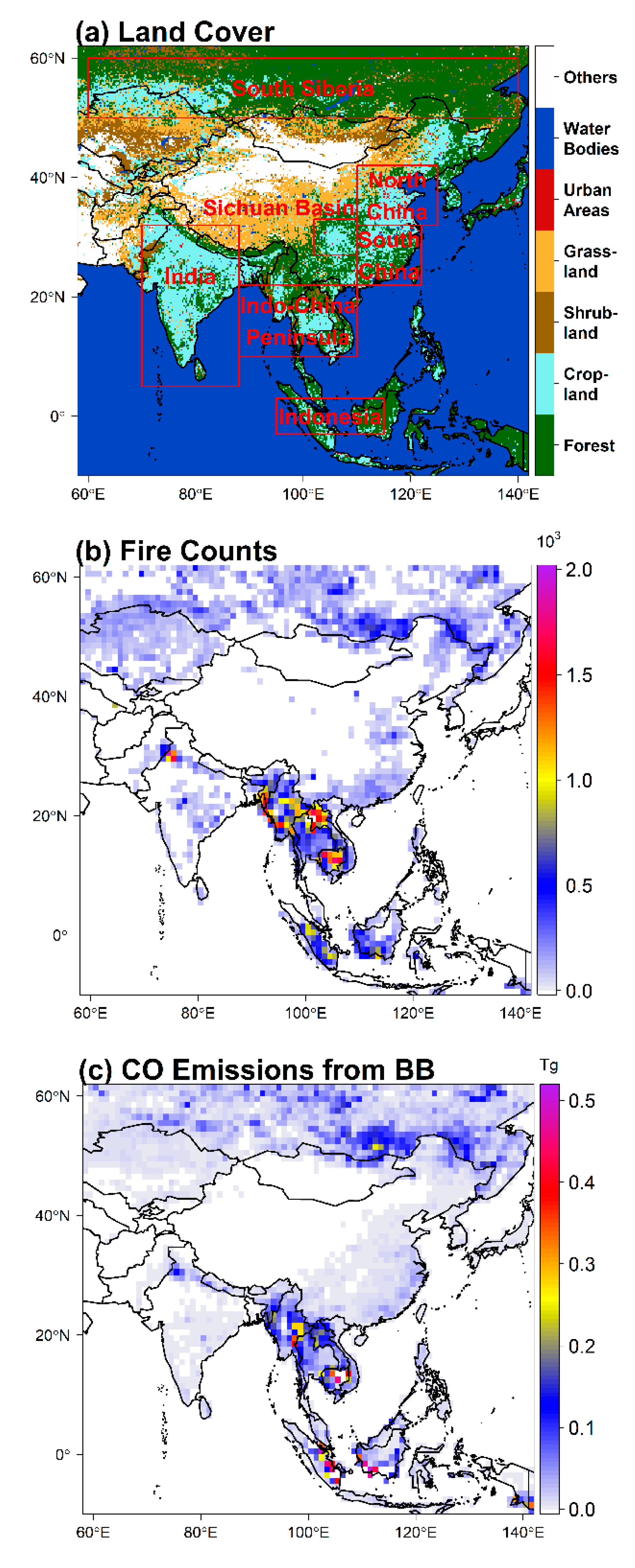
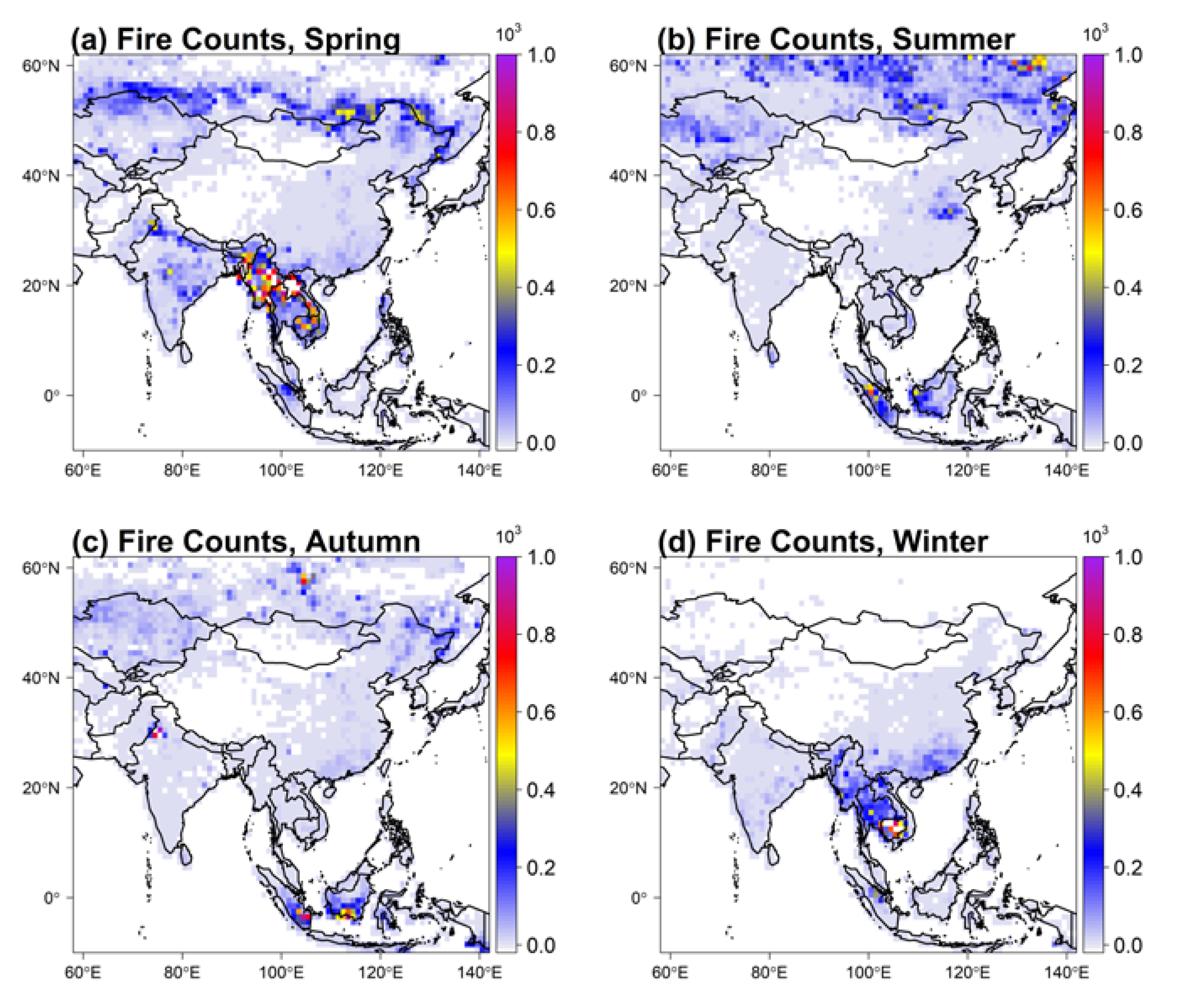
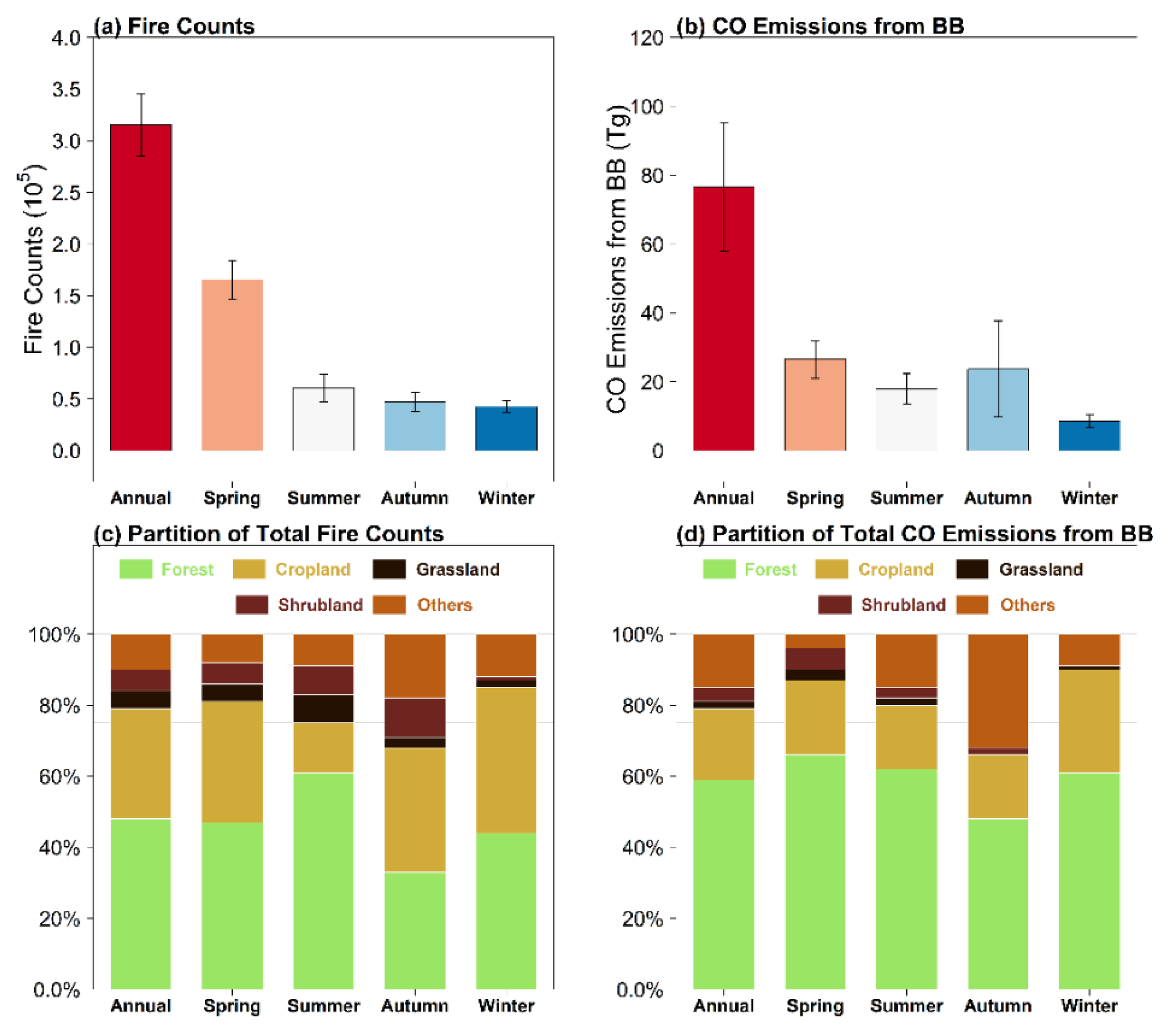
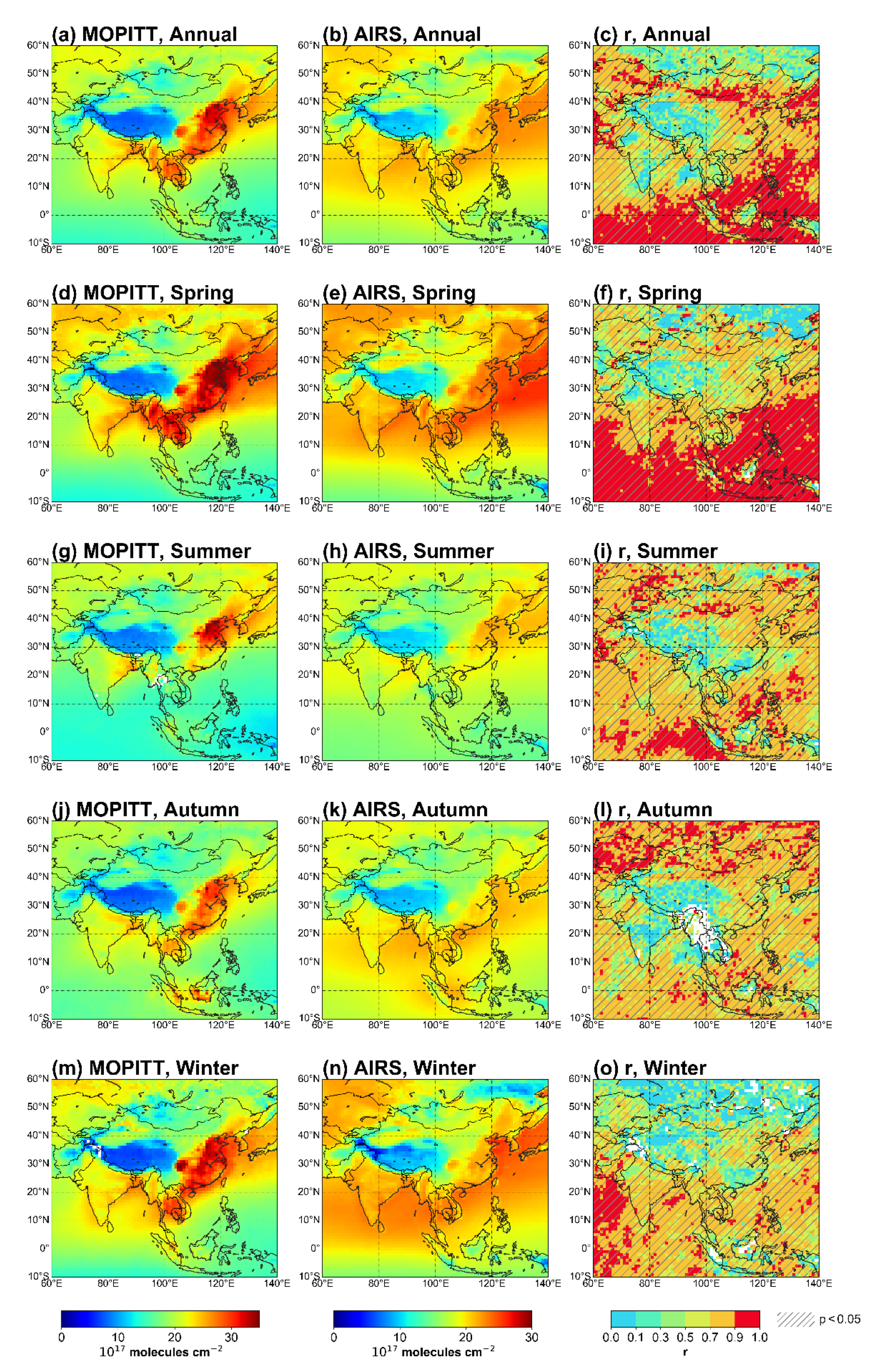
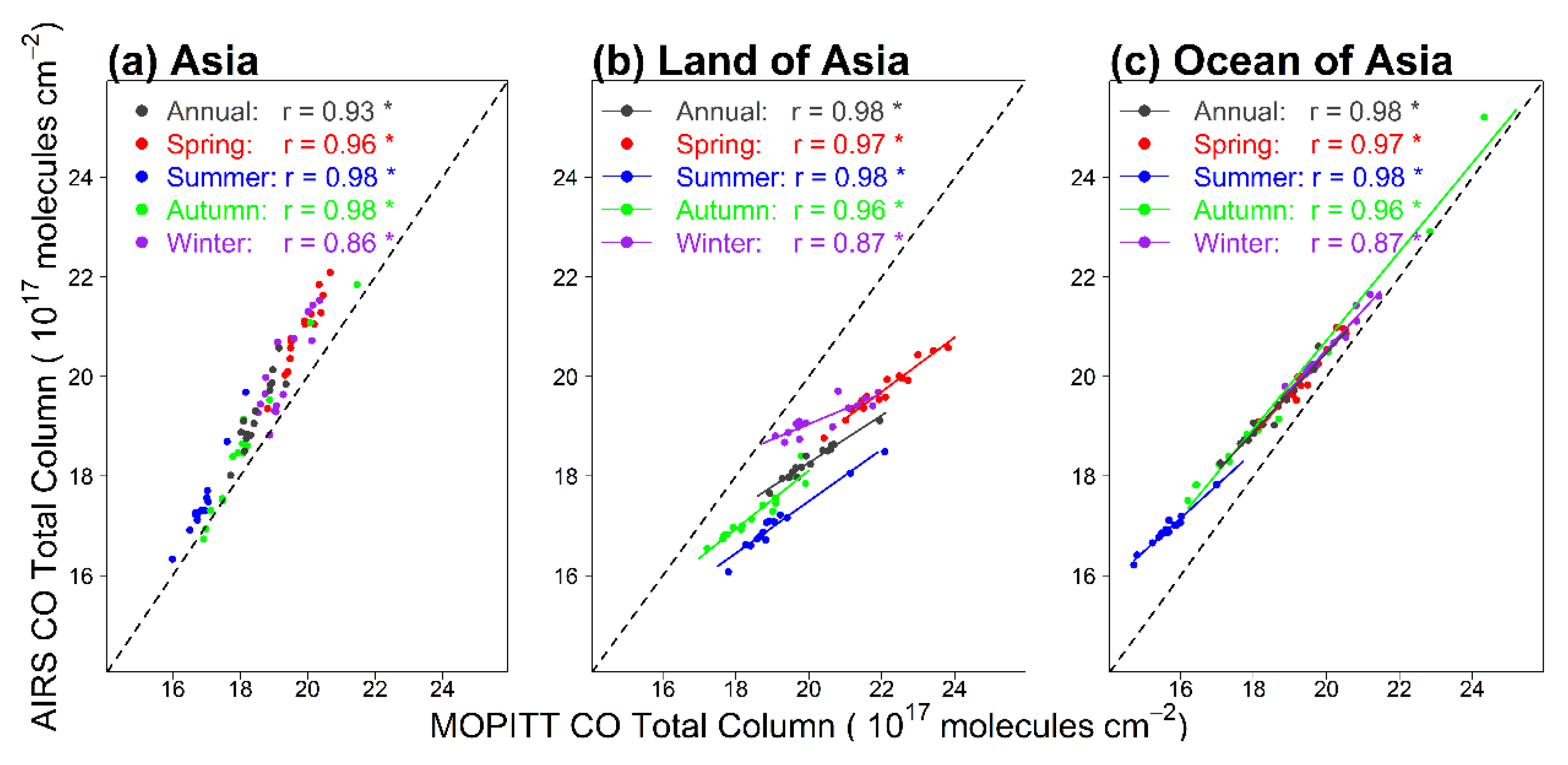
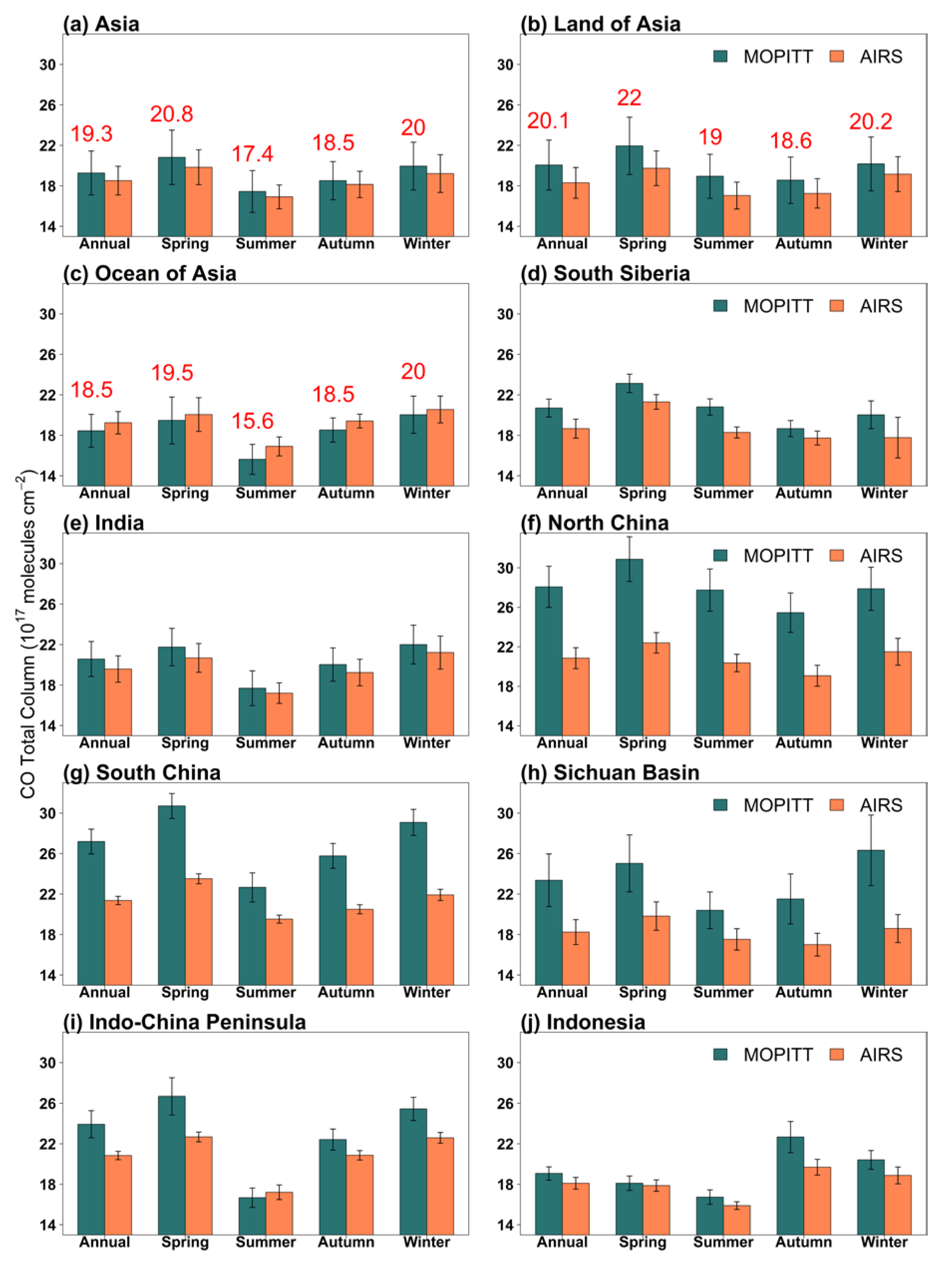
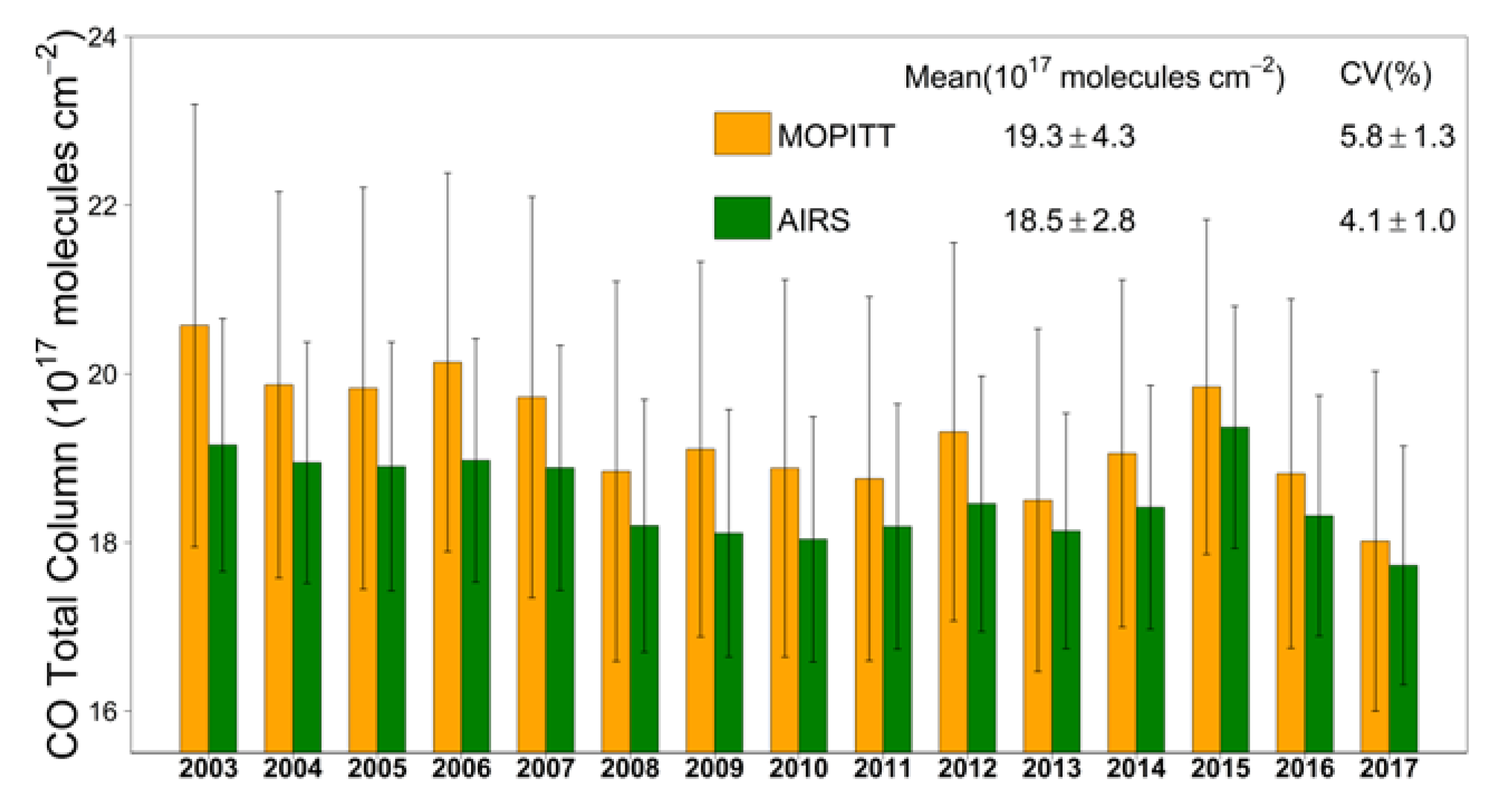
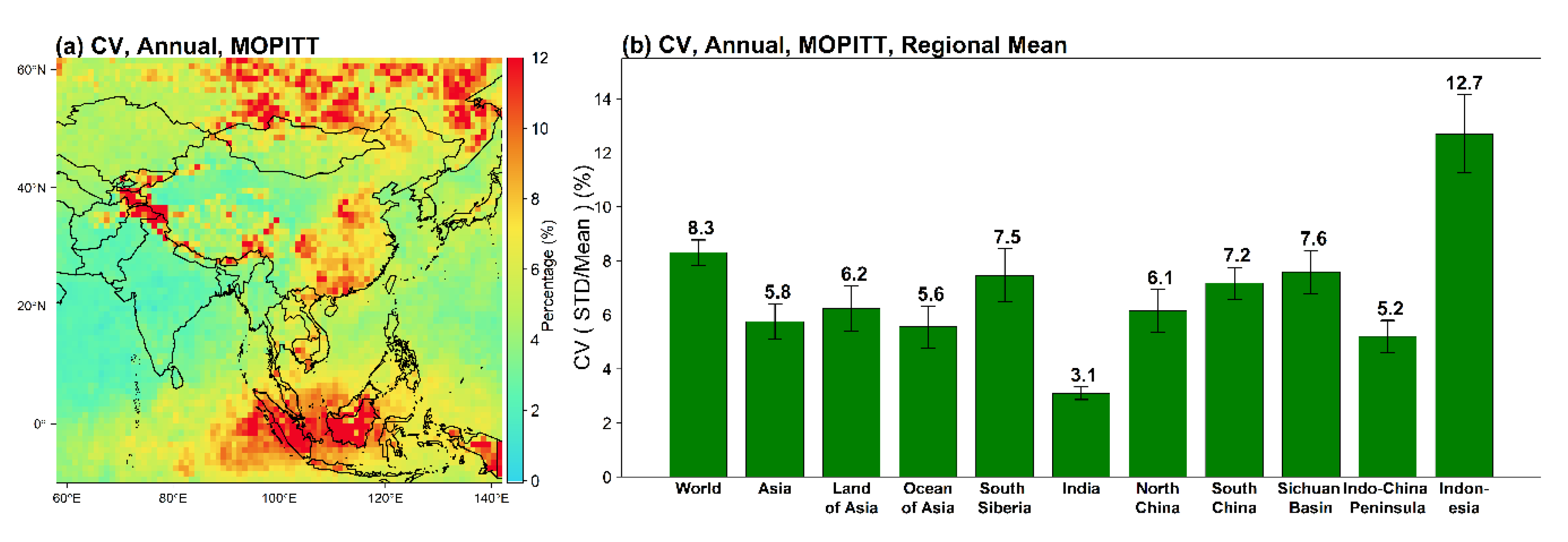
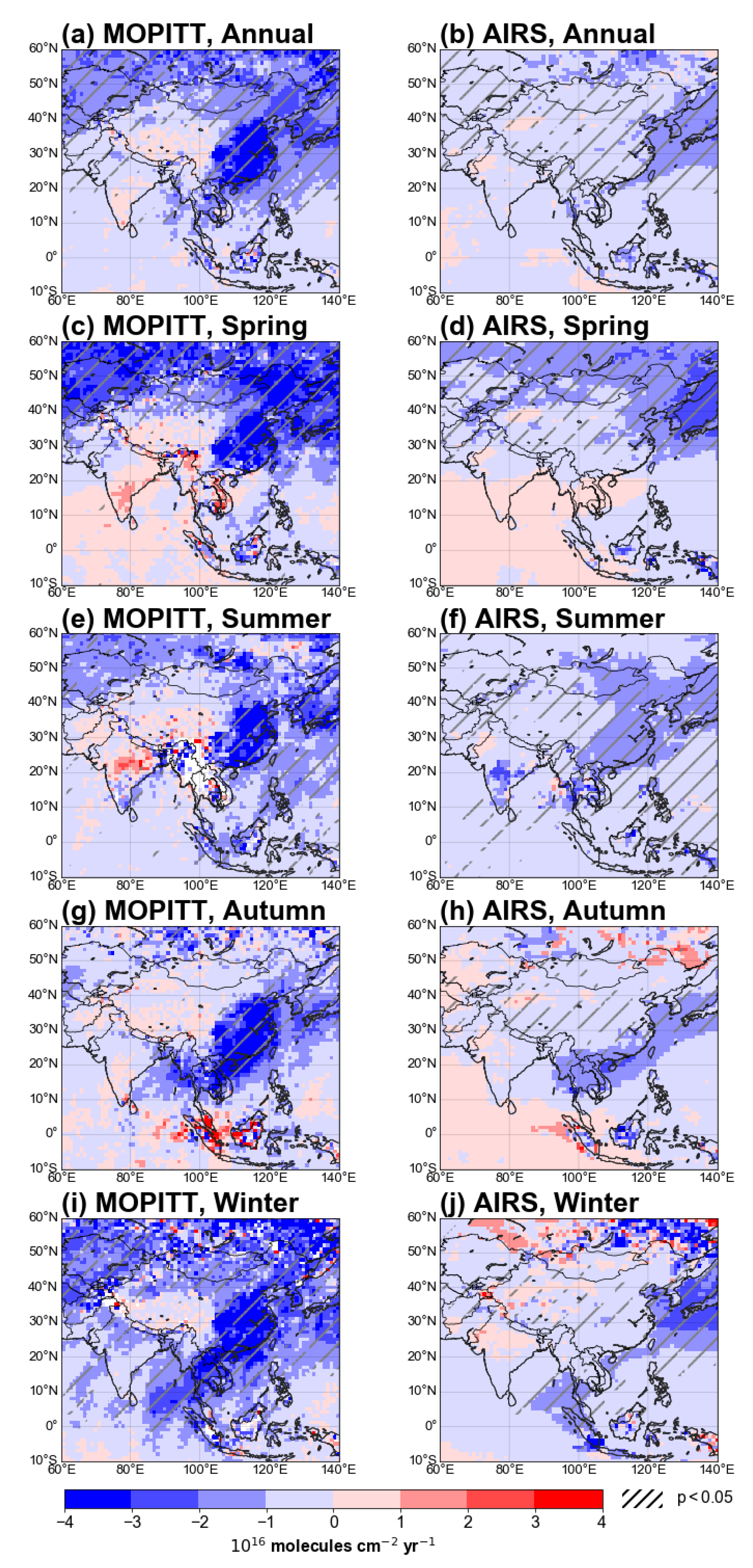
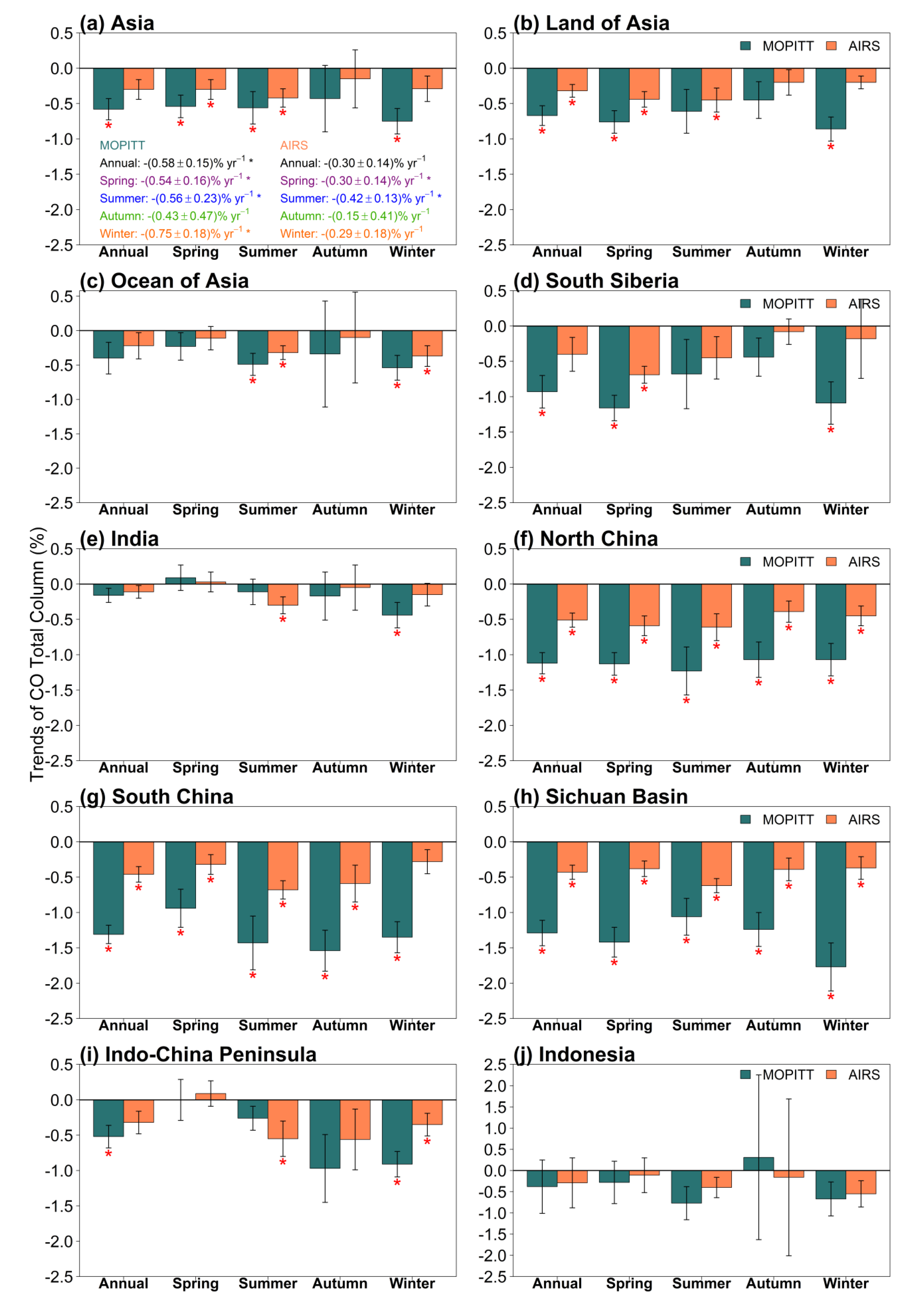
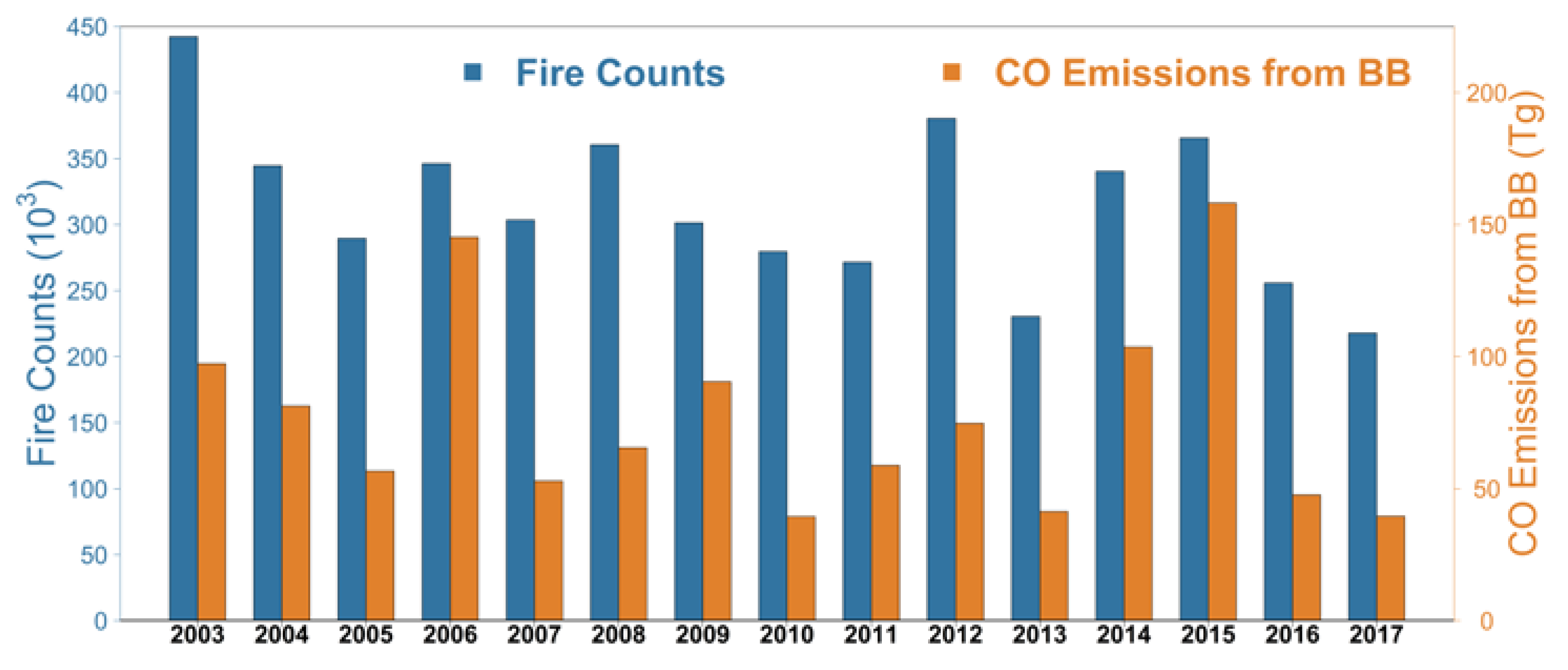
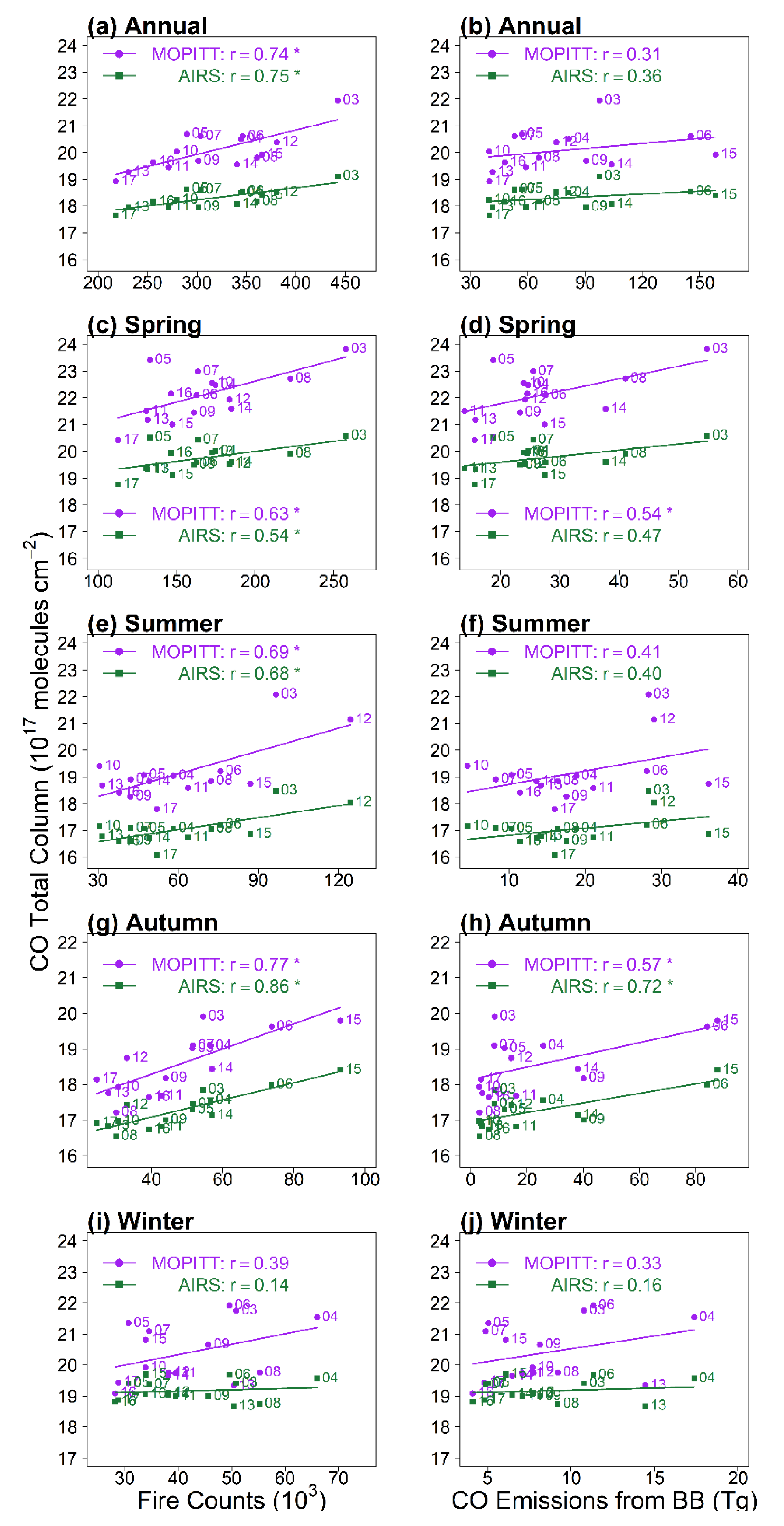
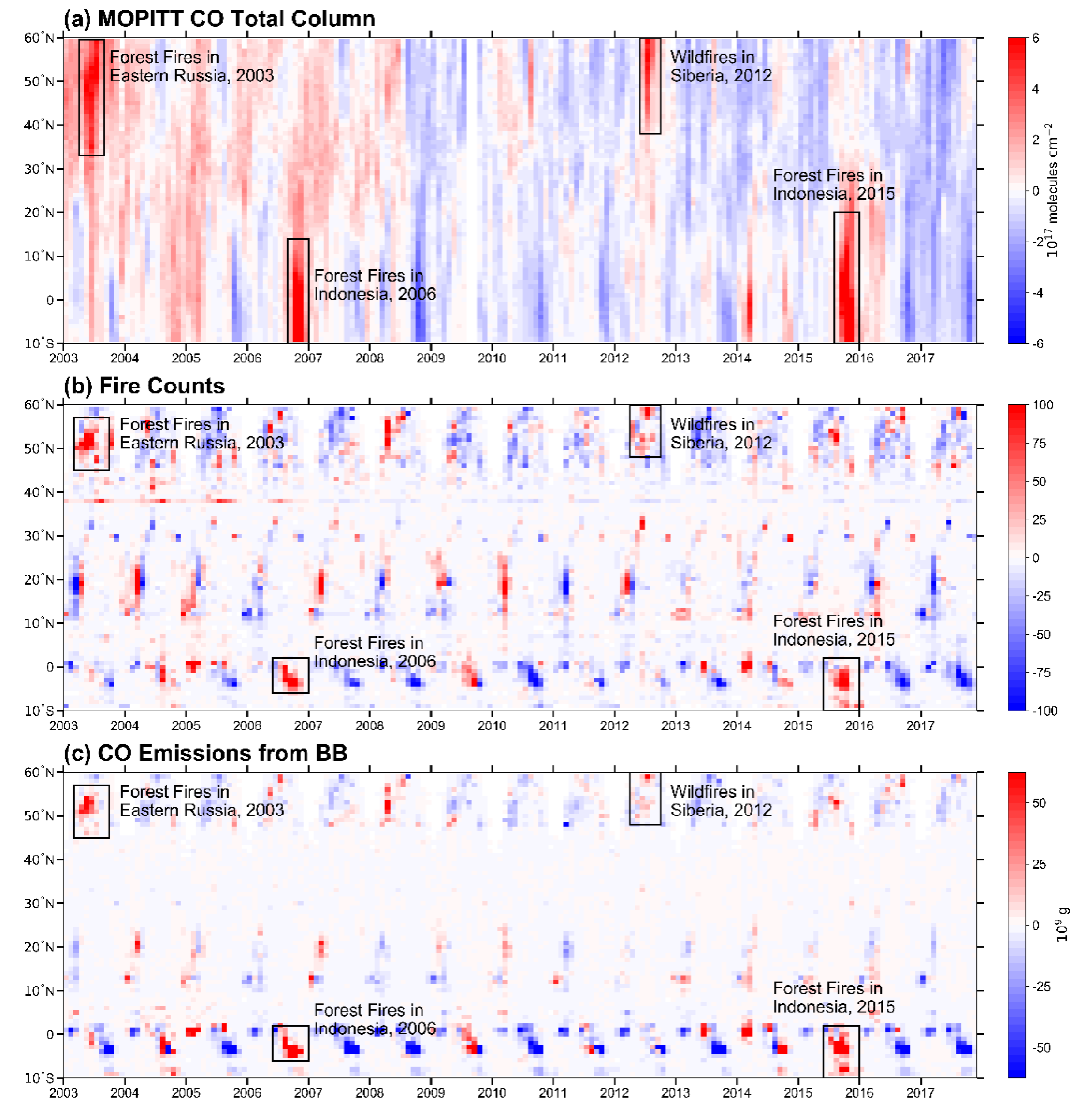
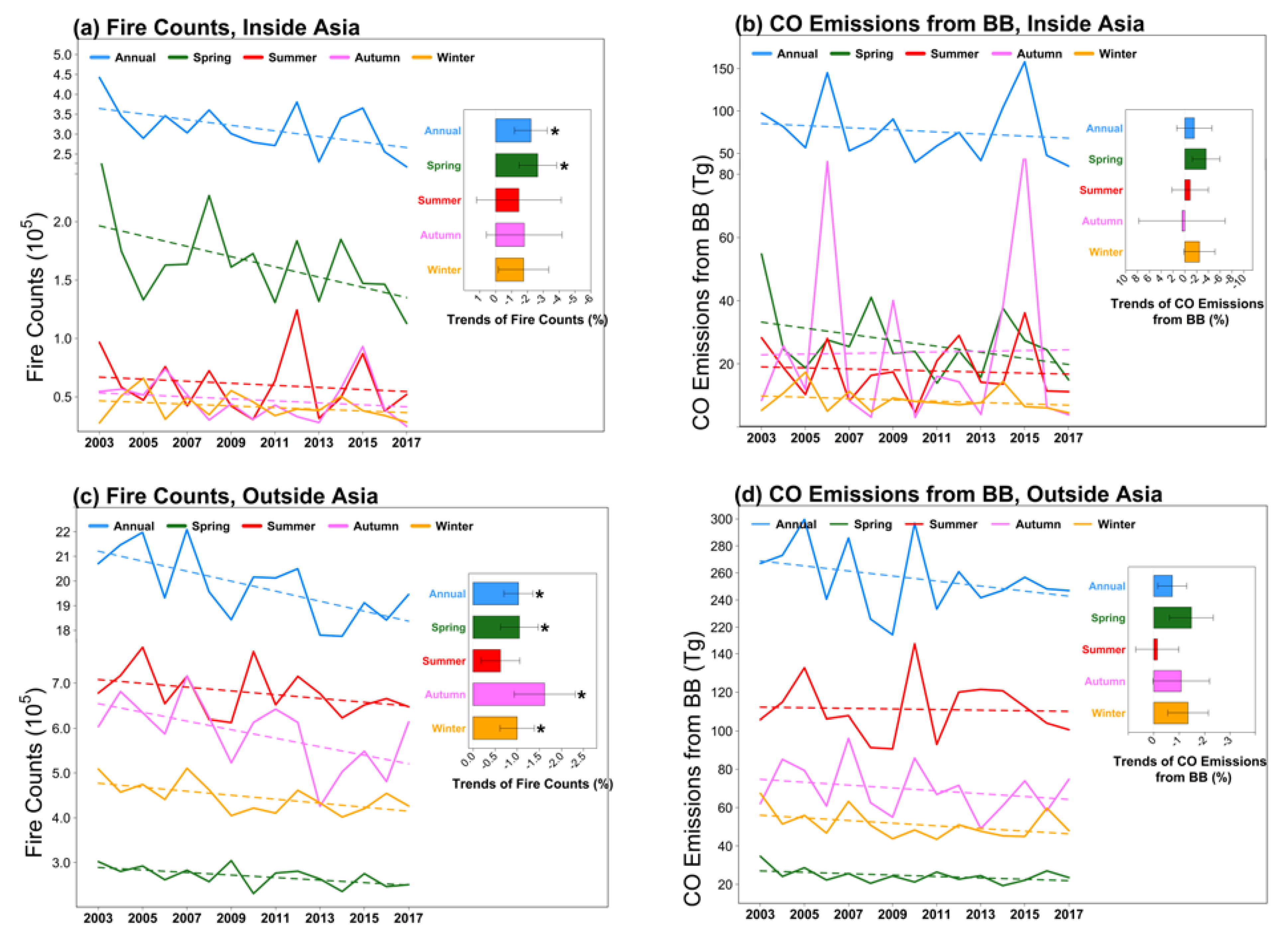
| Regions | Annual | Spring | Summer | Autumn | Winter |
|---|---|---|---|---|---|
| World | −0.09 ± 0.02 | −0.08 ± 0.04 | −0.08 ± 0.02 | −0.08 ± 0.04 | −0.07 ± 0.03 |
| Asia | −0.11 ± 0.03 | −0.11 ± 0.03 | −0.10 ± 0.04 | −0.08 ± 0.09 | −0.15 ± 0.04 |
| Asia (land) | −0.13 ± 0.03 | −0.17 ± 0.03 | −0.12 ± 0.06 | −0.08 ± 0.05 | −0.17 ± 0.03 |
| Asia (ocean) | −0.07 ± 0.04 | −0.04 ± 0.04 | −0.08 ± 0.03 | −0.06 ± 0.14 | −0.11 ± 0.04 |
| South Siberia | −0.19 ± 0.05 | −0.27 ± 0.04 | −0.14 ± 0.10 | −0.08 ± 0.05 | −0.22 ± 0.06 |
| India | −0.03 ± 0.02 | 0.02 ± 0.04 | −0.02 ± 0.03 | −0.03 ± 0.07 | −0.10 ± 0.04 |
| North China | −0.32 ± 0.04 | −0.35 ± 0.05 | −0.34 ± 0.10 | −0.27 ± 0.06 | −0.30 ± 0.06 |
| South China | −0.36 ± 0.04 | −0.29 ± 0.08 | −0.32 ± 0.09 | −0.40 ± 0.08 | −0.39 ± 0.06 |
| Sichuan Basin | −0.30 ± 0.04 | −0.36 ± 0.05 | −0.22 ± 0.05 | −0.27 ± 0.05 | −0.46 ± 0.09 |
| Indo-China Peninsula | −0.13 ± 0.04 | −0.00 ± 0.08 | −0.04 ± 0.03 | −0.22 ± 0.11 | −0.23 ± 0.05 |
| Indonesia | −0.07 ± 0.12 | −0.05 ± 0.09 | −0.13 ± 0.07 | 0.06 ± 0.42 | −0.14 ± 0.08 |
| Regions | Land Cover | Annual | Spring | Summer | Autumn | Winter |
|---|---|---|---|---|---|---|
| Asia (land) | Forest | 0.79 | 0.71 | 0.77 | 0.54 | 0.38 |
| Grassland | 0.72 | 0.50 | 0.08 | 0.70 | −0.57 | |
| Shrubland | 0.55 | 0.23 | 0.17 | 0.82 | 0.28 | |
| Cropland | 0.19 | 0.12 | 0.46 | 0.74 | 0.28 | |
| South Siberia | All | 0.77 | 0.72 | 0.73 | 0.42 | −0.01 |
| India | All | −0.32 | 0.42 | 0.56 | −0.37 | −0.07 |
| North China | All | −0.37 | −0.80 | 0.04 | −0.45 | −0.49 |
| South China | All | 0.31 | −0.04 | −0.39 | 0.61 | 0.18 |
| Sichuan Basin | All | −0.39 | −0.09 | −0.60 | 0.34 | 0.09 |
| Indo-China Peninsula (land) | All | 0.60 | 0.49 | −0.23 | 0.76 | 0.75 |
| Indonesia | All | 0.84 | 0.84 | 0.78 | 0.95 | 0.81 |
| Regions | Land Cover | Annual | Spring | Summer | Autumn | Winter |
|---|---|---|---|---|---|---|
| Asia (land) | Forest | 0.53 | 0.67 | 0.60 | 0.54 | 0.41 |
| Grassland | 0.59 | 0.36 | −0.12 | 0.39 | −0.26 | |
| Shrubland | 0.27 | 0.09 | 0.49 | 0.30 | 0.25 | |
| Cropland | −0.04 | −0.17 | −0.01 | 0.51 | 0.12 | |
| South Siberia | All | 0.72 | 0.67 | 0.65 | −0.05 | 0.25 |
| India | All | 0.05 | 0.45 | 0.52 | 0.21 | 0.14 |
| North China | All | −0.53 | −0.74 | −0.24 | −0.43 | −0.58 |
| South China | All | −0.04 | −0.19 | −0.57 | 0.47 | 0.28 |
| Sichuan Basin | All | −0.86 | −0.62 | −0.83 | −0.48 | −0.43 |
| Indo-China Peninsula (land) | All | 0.62 | 0.55 | −0.22 | 0.45 | 0.81 |
| Indonesia | All | 0.86 | 0.79 | 0.73 | 0.90 | 0.76 |
© 2020 by the authors. Licensee MDPI, Basel, Switzerland. This article is an open access article distributed under the terms and conditions of the Creative Commons Attribution (CC BY) license (http://creativecommons.org/licenses/by/4.0/).
Share and Cite
Zhang, X.; Liu, J.; Han, H.; Zhang, Y.; Jiang, Z.; Wang, H.; Meng, L.; Li, Y.C.; Liu, Y. Satellite-Observed Variations and Trends in Carbon Monoxide over Asia and Their Sensitivities to Biomass Burning. Remote Sens. 2020, 12, 830. https://doi.org/10.3390/rs12050830
Zhang X, Liu J, Han H, Zhang Y, Jiang Z, Wang H, Meng L, Li YC, Liu Y. Satellite-Observed Variations and Trends in Carbon Monoxide over Asia and Their Sensitivities to Biomass Burning. Remote Sensing. 2020; 12(5):830. https://doi.org/10.3390/rs12050830
Chicago/Turabian StyleZhang, Xun, Jane Liu, Han Han, Yongguang Zhang, Zhe Jiang, Haikun Wang, Lingyun Meng, Yi Chen Li, and Yi Liu. 2020. "Satellite-Observed Variations and Trends in Carbon Monoxide over Asia and Their Sensitivities to Biomass Burning" Remote Sensing 12, no. 5: 830. https://doi.org/10.3390/rs12050830
APA StyleZhang, X., Liu, J., Han, H., Zhang, Y., Jiang, Z., Wang, H., Meng, L., Li, Y. C., & Liu, Y. (2020). Satellite-Observed Variations and Trends in Carbon Monoxide over Asia and Their Sensitivities to Biomass Burning. Remote Sensing, 12(5), 830. https://doi.org/10.3390/rs12050830









